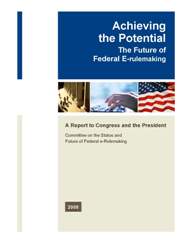CTG participates in blue ribbon report on the future of e-rulemaking
 The Committee on the Status and Future of Federal e-Rulemaking recently issued a report to the President and Congress on the current state and future potential of federal e-rulemaking – the systems and processes that support the dialog and decisions that surround federal regulations. Sponsored by the Section of Administrative Law & Regulatory Practice of the American Bar Association, the non-partisan Committee was chaired by Sally Katzen, former Administrator of the Office of Information and Regulatory Affairs and Deputy Director for Management at OMB. Members included more than 20 experts, researchers and practitioners, including CTG senior fellow Sharon Dawes. The report was prepared by Cynthia Farina, Professor of Law at Cornell University.
The Committee on the Status and Future of Federal e-Rulemaking recently issued a report to the President and Congress on the current state and future potential of federal e-rulemaking – the systems and processes that support the dialog and decisions that surround federal regulations. Sponsored by the Section of Administrative Law & Regulatory Practice of the American Bar Association, the non-partisan Committee was chaired by Sally Katzen, former Administrator of the Office of Information and Regulatory Affairs and Deputy Director for Management at OMB. Members included more than 20 experts, researchers and practitioners, including CTG senior fellow Sharon Dawes. The report was prepared by Cynthia Farina, Professor of Law at Cornell University.
According to the report Achieving the Potential: The Future of Federal e-Rulemaking, A Report to Congress and the President, “E-rulemaking has transformative potential to increase the comprehensibility, transparency and accountability of the regulatory process. Specifically, e-rulemaking – effectively implemented – can open the rulemaking process to a broader range of participants, offer easier access to rulemaking and implementation materials, facilitate dialogue among interested parties about policy and enforcement, enhance regulatory coordination, and help produce better decisions that lead to more effective, accepted and enforceable rules.”
The report recommends that the federal government:
- Design new governance, management, and funding approaches to foster better and more timely decision-making, incorporate the perspectives of stakeholders including the public, and provide financial stability through a dedicated appropriation.
- Develop techniques to achieve more effective forms of public involvement to expand and extend public participation.
- Enhance the capabilities of the Federal Docket Management System so it can effectively support agencies with modest rulemaking activities, while opening the system to a dynamic process of growth and innovation in which new functions, tools and services are developed by both the larger rulemaking agencies and by interested individuals and organizations outside the government.
- Provide more complete and understandable access to regulatory materials through an enhanced governwide portal. Encourage agencies to use their own Web sites to offer more detailed online presentations of specific programs, rules and issues.
- Improve the efficacy of the process and rulemaking outcomes by discovering and disseminating e-rulemaking best practices; identifying and overcoming barriers to the evolution of e-rulemaking; and encouraging agencies to explore innovative tools and methods for information management and interaction with the public.
The report has been endorsed by 14 organizations including the National Academy of Public Administration, the Information Technology Association of America, and the Center for Democracy and Technology.